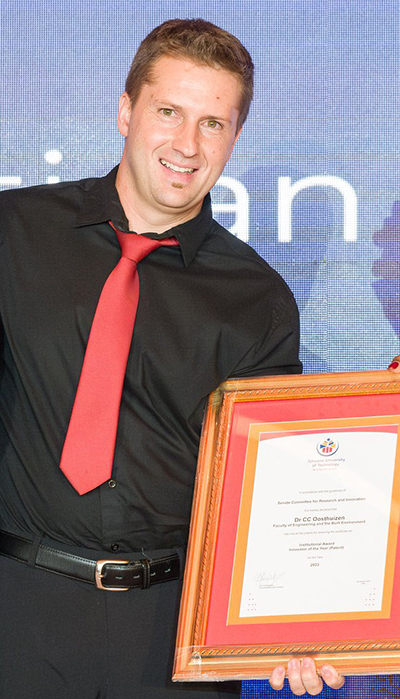The Tshwane University of Technology (TUT) prides itself as a University that makes knowledge work. Embodied in this statement are the academics, researchers, students, funders and industry partners whose contributions enable the University to quantify this bold assertion in the form of research outputs.

Dr Christiaan Oosthuizen is the recipient of the Innovator of the Year Award (Patent) at TUT’s recent Academic Excellence Awards.
One such individual is Dr Christiaan Oosthuizen, Senior Lecturer and Group Leader for Mechatronics Engineering. He is also the recipient of the Innovator of the Year Award (Patent) at this year’s Academic Excellence Awards.
The awards are hosted by the Vice-Chancellor and Principal, Professor Tinyiko Maluleke, to recognise outstanding performance and achievements by academics and researchers.
In 2023 alone, TUT was granted five patents, three of which are a result of the hard work of Dr Oosthuizen, his team and students.
Phumla Mkize chats to Dr Oosthuizen who is behind one of the University’s award-winning projects the TUT Solar Car - SunChaser.
Question: Innovator of the Year Award (Patent) at a university of technology! This is the quintessential award for any knowledge generating institution. What does the award mean to you?
Answer: I am honoured and humbled by this award, but first, I would like to acknowledge the rest of the TUT Sunchaser Solar Car team. From appointed student assistants, student bursary holders and to fellow staff members working on the project, their contributions made these innovations a reality. This award is encouraging and motivates me to push the boundaries even more.
I filed three patents during 2022, and officially registered all three patents in 2023. All three patents are registered in South Africa, with one now also additionally filed for an international patent application in the UK, China and Germany.
For a layperson, what are patents?
A patent is a legal right that gives an inventor exclusive control over their invention for a set period, preventing others from making, using or selling it without permission.
They are a way to protect inventions and encourage innovation by giving creators a temporary monopoly over their ideas.
Can you tell me more about the patents that have earned you this recognition?
One is the electromechanical brake pedal. Essentially it is a brake pedal that does a lot more than decrease the speed or stop the car. It also recovers electrical energy back into the battery. This prototype is implemented on the Sunchaser4 Solar Car and has driven about 7 000km on national highways.
The other is a cooling system for a motor. This cooling system is much lighter than conventional liquid cooling and provides us with an effective and inexpensive way of cooling the motor very quickly during scenarios where they might heat up and underperform, such as when traversing steep mountains. This is the patent filed for registration in multiple countries.
The last one is the range estimation system and method. This patent has to do with a mathematical algorithm I partially developed during my doctoral studies a few years ago.
It takes a bunch of parameters and then very accurately predicts or forecasts the remaining range the vehicle will be able to drive, up to eight days into the future.
This algorithm is partly responsible for our solar car’s extraordinary performance at the local events over the last years. In 2023, TUT’s SunChaser won the annual Bridgestone Ilanga Cup Championship, making it the second consecutive win after winning the competition in 2022.
What is role of patents in a higher education institution?
First, it’s about students. Most of my patents have some percentage of student involvement co-registered on the patent. I give students an opportunity to work on a special project with me and we co-patent, the percentage contribution is determined by the student involvement. This way we stimulate out-of-the-box thinking and a mindset of innovation. We are training students to be future ready.
TUT also gets incentives from the Department of Higher Education and Training, a few years after registration of the patent takes place, similar to when a journal gets published.
What happens after patents have been granted?
We try to market them to interested stakeholders in industry with the aim of licensing, which could generate third-stream income. This is a lengthy process, but a necessary one.
Are you working on anything interesting now?
Some lithium battery technologies and battery management system technologies. They are not at the point of patenting yet though.
What are your plans for 2025?
Our team still is working very hard to get our brand-new multi-seater solar to a “rolling-chassis” level by the end of this year. The aim is that the battery is in the car, the motors, the brakes, steering and suspension. Most of these components mentioned have been designed and manufactured on campus. We are very proud of in-house skills and manufacturing.
For next year, we would like to continue the vehicle which eventually, in a few years, could be registered as a regular road vehicle. Not for mass production, though, but to showcase our expertise in developing a car from the ground up and passing all regulatory tests to be able to register as any other car on the road today.
What do you do to relax? Any interests or hobbies?
I enjoy working on projects around the house with my three-year-old son and wife. We also love the outdoors; going on hikes and camping as often as six times a year. My hobbies are really aligned with my work, that is, the solar car project.
